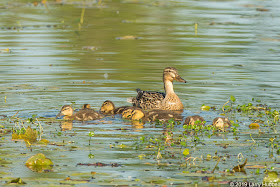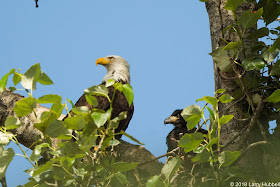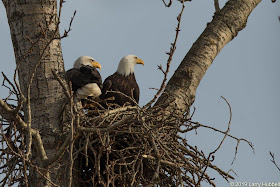On Mother's Day, focusing on this female Mallard and her ducklings seems rather sweet and appropriate. Even from a distance, the mother hen is clearly watching for danger, while also keeping all of her ducklings in sight.
Multiple times this week this family has been seen on Duck Bay. I admit I am assuming they are the same family unit, primarily, because the number of ducklings has consistently been seven.
Earlier in the week, the ducklings looked visibly smaller. It is possible that I just happened to stumble across two different families, never at the same time, with the same number of ducklings. It is also feasible that the size difference in the ducklings just happened to give the impression of growth over time.
On the other hand, I like to think that this is an exceptional Mallard Hen. She not only laid, incubated and hatched her ducklings prior to most other females, but she has also apparently successfully protected her seven ducklings in a bay full dangers.
Earlier in the week, Duck Bay was in a consistently frothy state with large carp spawning everywhere. Stealthy, Great Blue Herons stalked the shallow waters along the shore. Frequently, a Bald Eagle would sit overhead in a dead cottonwood and search the water for food - most likely Albert from the Broadmoor Eagle's nest. One afternoon, two second-year Cooper's Hawks lazily circled overhead while drifting towards the southwest. All of these creatures were focused on finding food and young ducklings would have easily fit the bill.
So far, these seven ducklings seem to be leading charmed lives. Like many of us, I suspect their good luck originates from paying attention to their mother. Regardless of your species, listening to your mother is the first key to survival.
At the other end of the spectrum is Marsha. She is quite possibly the most protective mother around Union Bay. Marsha is the Bald Eagle sitting on the left. Her mate, Monty, is the smaller eagle to the right. Immediately next to Marsha is the latest addition to the family. Of course in this photo, taken from the far side of Montlake Cut, the small eaglet is nearly impossible to see.
Even with an enlarged photo the fuzzy, little head, peering between the 'V' of upright sticks, is at the limits of perception.
Here is one more distant shot with the young eaglet's head facing to our right. So far this year, I have only seen the single young eaglet in Monty and Marsha's nest.
Last year, Monty and Marsha had two young. The challenges they faced - nest falling, injured eaglet, etc - have been covered extensively in prior posts. Click Here for more details.
The real reason I included this photo is to show Marsha's ferocious attitude. Here, she was focused on a crow who threatened to interrupt the feeding of her young. Her maternal instinct is not just about being sweet and kind, she is also strong, fierce and protective.
Marsha is the only eagle I have ever seen carry a fish without using her talons. Bald Eagles normally carry extra weight under their tails. True, it was a relatively small fish. Still, I think the casual way she carries it helps to demonstrate her size and strength.
In fact, female Bald Eagles are consistently larger and, in my experience, more ferocious than the males. Marsha is obviously the bird on the left while Monty is the sweeter-looking eagle on the right. I have no doubt, the emblem of our nation is modeled after a female Bald Eagle.
When an immature (most likely unrelated) Bald Eagle sat overhead watching Marsha eat, she was not intimidated. Still, she did not want to take a chance of loosing her food, so she called incessantly for Monty to come and chase the young eagle away. After he did, she quietly resumed her meal.
This winter photo, of Marsha, preparing to consume an American Coot, communicates her fierceness far more than words can say.
At the same time, while in the nest and focused on her young, Marsha can be a gentle as a feather falling in a summer breeze.
Even after one grows up, having your mother watching out for you, is a feeling to be treasured. Happy Mother's Day to one and all!
This week's post is dedicated to the mothers who love us, and most especially to mine!
Have a great day on Union Bay...where nature lives in the city!
Larry
Going Native:
Without a well-funded Environmental Protection Agency, it falls to each of us to be ever more vigilant in protecting our local environments. Native plants and trees encourage the largest diversity of lifeforms because of their long intertwined history with our local environment and native creatures. I have been told that even the microbes in the soil are native to each local landscape. My hope is that we can inspire ourselves, our neighbors and local businesses to respect native flora and to support native wildlife at every opportunity. I have learned that our most logical approach to native trees and plants (in order of priority) should be to:
1) Learn and leave established native flora undisturbed.
2) Remove invasive species and then wait to see if native plants begin to grow without assistance. (If natives plants start on their own, then these plants or trees are likely the most appropriate flora for the habitat.)
3) Scatter seeds from nearby native plants in a similar habitat.
4) If you feel you must add a new plant then select a native plant while considering how the plant fits with the specific habitat and understanding the plant's logical place in the normal succession of native plants.
My intention in my weekly post is to include at least one photo each week and visually challenge us to know the difference between native and non-native lifeforms.
1) Learn and leave established native flora undisturbed.
2) Remove invasive species and then wait to see if native plants begin to grow without assistance. (If natives plants start on their own, then these plants or trees are likely the most appropriate flora for the habitat.)
3) Scatter seeds from nearby native plants in a similar habitat.
4) If you feel you must add a new plant then select a native plant while considering how the plant fits with the specific habitat and understanding the plant's logical place in the normal succession of native plants.
My intention in my weekly post is to include at least one photo each week and visually challenge us to know the difference between native and non-native lifeforms.
Is this a native or non-native caterpillar?
Scroll down for the answer.
***************
Sorry, this is another case where I do not know the answer. I am wondering if anyone is aware of a good book for identifying caterpillars. This particular individual was hanging from a Red Alder branch and climbing furiously to get back to the leaves and away from the water below.
***************
The Email Challenge:
Over the years I have had many readers tell me that Google is no longer sending them email announcements regarding my posts. Even more frustrating when they go to 're-sign-up', hoping that will enable them to once again start receiving the announcements, they get a message which says 'Sorry, you are already signed up.' Google has not responded to my requests for help with this issue.
My functional workaround is to set up my own email list and each week I manually send out a new post announcement. If you are experiencing the issue and would like to be added to my personal email list please send me an email requesting to be added. Thank you for your patience!
My email address is LDHubbell@comcast.net















Hi Larry - thank you for this excellent post. I have a question about the female mallard. I am quite a novice beginner at bird watching. I noted the blue—ish colored feathers in the hind quarter of the female. How would you tell this female from a juvenile mallard?
ReplyDeleteThe bluish or purplish feathers (with white borders above and below) are the speculum and are unique to Mallards - in those colors. By this time of year all the Mallards hatched last year should be fully mature. So, at this point, they only young (2019) birds will be smaller than the adults. As the season progresses, and the young birds grow you will see larger groups of nearly full grown 'ducklings' still following their mother. Generally, she will still be slightly larger, until she isn't. At which point I am not sure how you would tell them apart. Thanks for asking!
ReplyDelete